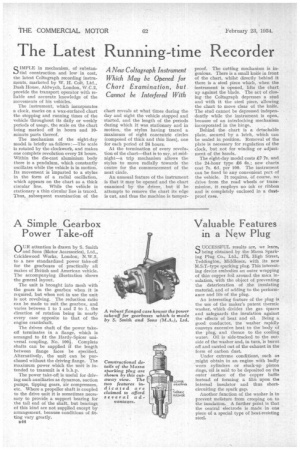The Latest Running-time Recorder
Page 58

If you've noticed an error in this article please click here to report it so we can fix it.
A New Coltagraph Instrument Which May be Opened for Chart Examination, but. Cannot be Interfered With
SIMPLE in mechanism, of substantial construction and low in cost, the latest Coltagraph recording instruments, marketed by W. H. Colt, Ltd., Bush House, Aldwych, London, W.C.2, provide the transport operator with reliable and accurate knowledge of the movements of his vehicles.
The instrument, which incorporates a clock, marks on a wax-surfaced chart the stopping and running times of the vehicle throughout its daily or weekly periods of usage, the scale on the chart being .marked off in hours and 10minute parts thereof.
The mechanism of the eight-day model is briefly as. follows:—The scale is rotated by the clockwork, and makes one complete revolution every 24 hours. Within the die-cast aluminium body there is a pendulum, which constantly oscillates while the vehicle is in motion. Its movement is imparted to a stylus in the form of a radial oscillation, which appears on the chart as a thick circular line. While the vehicle is stationary a thin circular line is traced. Thus, subsequent examination of the chart reveals at what times during the day and night the vehicle stopped and started, and the length of the periods during which it was stationary and in motion, the stylus having traced a maximum of eight concentric circles (composed of thick and thin lines), one for each period of 24 hours.
At the termination of every revolution of the chart—that is to say, at midnight—a trip mechanism allows the stylus to move radially towards the centre for the commencement of the next circle.
An unusual feature of the instrument is that it may be opened and the chart examined by the driver, but if he attempts to remove the chart its edge is cut, and thus the machine is tamper
proof. The cutting mechanism is ingenious. There is a syreill knife in front of the chart, whilst directly behind it there is a steel piece which, when the instrument is opened, hits the chart up against the blade. The act of clos-' ing the Coltagraph depresses a stud and with it the steel piece, allowing the chart to move clear of the knife. The stud cannot be depressed independently while the instrument is open, because of an interlocking mechanism incorporated in the hinge.
Behind the chart is a detachable plate, secured by a -latch, which can be sealed in position. Removal of the plate is necessary for regulation of the clock, but not for winding or adjustment of the hands.
The eight-day model costs £7 7s. and the 24-hour type £6 6s.: new charts cost 7s, 6d. per 100. The instrument can be fixed to any convenient part of the vehicle. It requires, of course, • no drive from the road wheels or transmission, it employs no ink or ribbon and is completely enclosed in a dustproof. case,




























































































